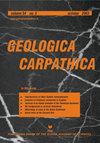Changes in the composition of trace fossil assemblages across the Paleocene–Eocene transition in the north-western Tethys (Untersberg section, Austria)
IF 1.5
4区 地球科学
Q4 GEOSCIENCES, MULTIDISCIPLINARY
引用次数: 0
Abstract
Abstract The Untersberg section (Northern Calcareous Alps, Austria) provides an expanded and biostratigraphically well constrained deep-sea record of the Paleocene–Eocene transition in the north-western Tethyan realm. At the base of the Eocene, massive carbonate dissolution and a shoaling of the calcite compensation depth (CCD) by at least 1 km is recorded by 5.5 m-thick red claystone, which is intercalated into a grey marlstone succession. Previous studies documented the benthic foraminifera extinction event (BEE) in this claystone. Now biodeformational structures and trace fossils were investigated in this interval to evaluate the impact of the extinction event on the macrobenthic tracemaker fauna. Using the stratigraphic distribution pattern of trace fossils, the lowermost Eocene claystone can be subdivided into three parts: (1) the lower part shows a trace fossil assemblage consisting of Chondrites isp., Planolites isp., Thalassinoides isp., and Zoophycos isp., (2) the middle part is characterized by primary sedimentary lamination and exceedingly rare ichnofossils, and (3) the upper part shows a less abundant and less diverse trace fossil assemblage than the lower part, indicating a slow recovery of the macrobenthic tracemaker community. This pattern demonstrates that macrobenthic communities were severely affected by the ecological perturbations in the earliest Eocene. The change in sediment colouration towards red colour in the middle part of the Paleocene–Eocene transition at the Untersberg section, together with decrease in bioturbation degree indicate that oxygen consumption was rather reduced during the PETM, and the loss in bioturbation is thus unrelated to oxygen limitation. Trace fossils can be used to improve the resolution of the benthic extinction interval and provide an excellent proxy for the precise determination of timing of the climax of this global event.奥地利Untersberg剖面特提斯西北部古新世-始新世过渡时期微量化石组合组成的变化
摘要Untersberg剖面(奥地利北部钙质阿尔卑斯山)提供了特提斯地区西北部古新世-始新世过渡的扩展和生物地层学约束良好的深海记录。在始新世底部,5.5 m厚的红色粘土岩记录到大量碳酸盐溶解和方解石补偿深度(CCD)至少1 km的变浅,该粘土岩嵌入灰色泥灰岩序列中。先前的研究记录了该粘土岩中的底栖有孔虫灭绝事件。现在,在这段时间内对生物变形结构和痕迹化石进行了调查,以评估灭绝事件对大型底栖动物群的影响。根据痕迹化石的地层分布模式,最下部的始新世粘土岩可分为三部分:(1)下部显示由球粒陨石组成的痕迹化石组合。,Planolites isp。,大麻素类。,和Zoophycos isp。,(2) 中部以原生沉积叠层和极为罕见的遗迹化石为特征。(3)上部的痕迹化石组合不如下部丰富,多样性也较低,表明大型底栖动物痕迹制造者群落恢复缓慢。这种模式表明,早在始新世,大型底栖动物群落就受到了生态扰动的严重影响。Untersberg剖面古新世-始新世过渡期中部沉积物颜色向红色变化,以及生物扰动程度的降低表明,在PETM期间,氧气消耗相当减少,因此生物扰动的损失与氧气限制无关。痕迹化石可以用来提高海底生物灭绝间隔的分辨率,并为精确确定这一全球事件高潮的时间提供一个极好的替代品。
本文章由计算机程序翻译,如有差异,请以英文原文为准。
求助全文
约1分钟内获得全文
求助全文
来源期刊

Geologica Carpathica
地学-地球科学综合
CiteScore
2.40
自引率
23.10%
发文量
26
审稿时长
>12 weeks
期刊介绍:
GEOLOGICA CARPATHICA covers a wide spectrum of geological disciplines including geodynamics, tectonics and structural geology, volcanology, stratigraphy, geochronology and isotopic geology, karstology, geochemistry, mineralogy, petrology, lithology and sedimentology, paleogeography, paleoecology, paleobiology and paleontology, paleomagnetism, magnetostratigraphy and other branches of applied geophysics, economic and environmental geology, experimental and theoretical geoscientific studies. Geologica Carpathica , with its 60 year old tradition, presents high-quality research papers devoted to all aspects not only of the Alpine-Carpathian-Balkanian geoscience but also with adjacent regions originated from the Mediterranean Tethys and its continental foreland. Geologica Carpathica is an Official Journal of the Carpathian-Balkan Geological Association.
 求助内容:
求助内容: 应助结果提醒方式:
应助结果提醒方式:


